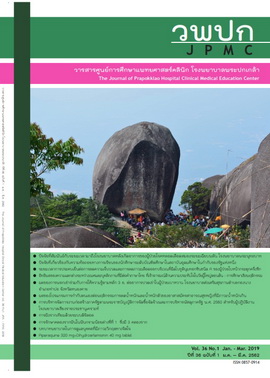The Influence of Gender and Personality Differences on Valence Emotional Words in Young Adults: A Behavioral Study
Main Article Content
Abstract
Background: Emotions are feelings caused by various stimuli, which can either be positive or negative. They can also be engaged in pleasure and unpleasure activities, and motivate some forms of behavior. As such, emotional education can help to gain valuable knowledge in the field of emotional science.
Objective: Compare the emotions of young adults classified by gender and personality while examining Thai words and the interaction between gender and personality.
Materials and methods: The purpose of this experimental research was to design experimental activities on valence emotions by examining Thai words, which could stimulate valence emotions in young adults by studying students in the 2018 academic year at Burapha University, Chonburi Province, Thailand. The 80 participants comprised 40 males and 40 females aged between 20 and 22 years old, who consisted of extravert and ambivert personality groups. An analysis of the basic statistics, percentage, mean and standard deviation was conducted. The variance of the variables was the behavioral perception of the emotions between the males and females, and extravert and ambivert personality with two-way ANOVA.
Results: The results showed the variance emotions of the test subjects between males and females were different when examining Thai words that stimulated emotions in an unpleasure activity that displayed a significant difference (p < 0.05).
Conclusion: The results showed that valence emotional words between males and females were different.
Article Details
References
Russell JA, Mehrabian A. Evidence for a three-factor theory of emotions. J Res Pers 1977; 1: 273-94.
Shiota M, Kalat J. Emotion Regulation. In: Shiota MN , Kalat JW; Editors. Emotion. 2nded. Belmont, CA : Wadsworth Cengage Learning; 2012. P 136-55.
Recio G, Schacht A, Sommer W. Recognizing dynamic facial expressions of emotion: specificity and intensity effects in event-related brain potentials. Biol psychol 2014;96:111-25.
Ngamprom C, Chadcham S, Wongupparaj P. Development of the affective norms for Thai words (Thai-ANW) bank system. Research Methodology & Cognitive Science 2018;15(2):162-78.
Kret ME, De Gelder B. A review on sex differences in processing emotional signals. Neuropsychologia 2012;50:1211-21.
Lucas RE, Baird BM. Extraversion and emotional reactivity. J Pers Soc Psychol 2004;86:473-85.
Tangkittipaporn J. General psychology. Bangkok: Chulalongkorn University Press; 2013.
McCrae RR, Costa PT Jr. Reinterpreting the myers‐briggs type indicator from the perspective of the five‐factor model of personality. J Pers 1989;57:17-40.
Gutiérrez JLG, Jiménez BM, Hernández EG, Puente CP. Personality and subjective well-being: big five correlates and demographic variables. Pers Individ Dif 2005;38:1561-9.
Edmonds WA, Kennedy TD. An applied guide to research designs : quantitative, qualitative, and mixed methods. 2nded. Los Angeles : Sage Publications, Inc; 2017.
Faul F, Erdfelder E, Lang A-G, Buchner A. G* Power 3: a flexible statistical power analysis program for the social, behavioral, and biomedical sciences. Behavi Res Methods 2007; 39:175-91.
Bradley MM, Lang PJ. Measuring emotion: the self-assessment manikin and the semantic differential. J Behav Ther Exp Psychiatry 1994;25:49-59.
Zhang M, Zhang L, Yu Y, Liu T, Luo W. Women overestimate temporal duration: evidence from Chinese emotional words. Front Psycho 2017;8:4.
Whittle AJ, López M, Vidal-Puig A. Using brown adipose tissue to treat obesity–the central issue. Trends Mol Med 2011;17:405-11.
Wildgruber D, Pihan H, Ackermann H, Erb M, Grodd W. Dynamic brain activation during processing of emotional intonation: influence of acoustic parameters, emotional valence, and sex. Neuroimage 2002;1:856-69.
Schmitt DP, Realo A, Voracek M, Allik J. Why can't a man be more like a woman? sex differences in big five personality traits across 55 cultures. J Pers Soc Psychol 2008;94: 168-82.
Tok S, Koyuncu M, Dural S, Catikkas F. Evaluation of International Affective Picture System (IAPS) ratings in an athlete population and its relations to personality. Pers Individ Dif 2010; 49:461-6.
Soares AP, Pinheiro AP, Costa A, Frade CS, Comesaña M, Pureza R. Affective auditory stimuli: Adaptation of the international affective digitized sounds (IADS-2) for European Portuguese. Behav Res Methods 2013;45:1168-81.
Redondo J, Fraga I, Padrón I, Piñeiro A. Affective ratings of sound stimuli. Behav Res Method 2008;40:784-90.
